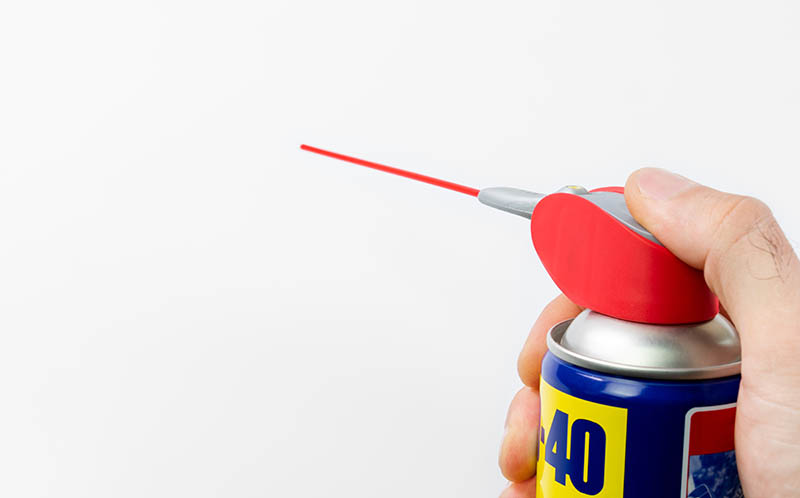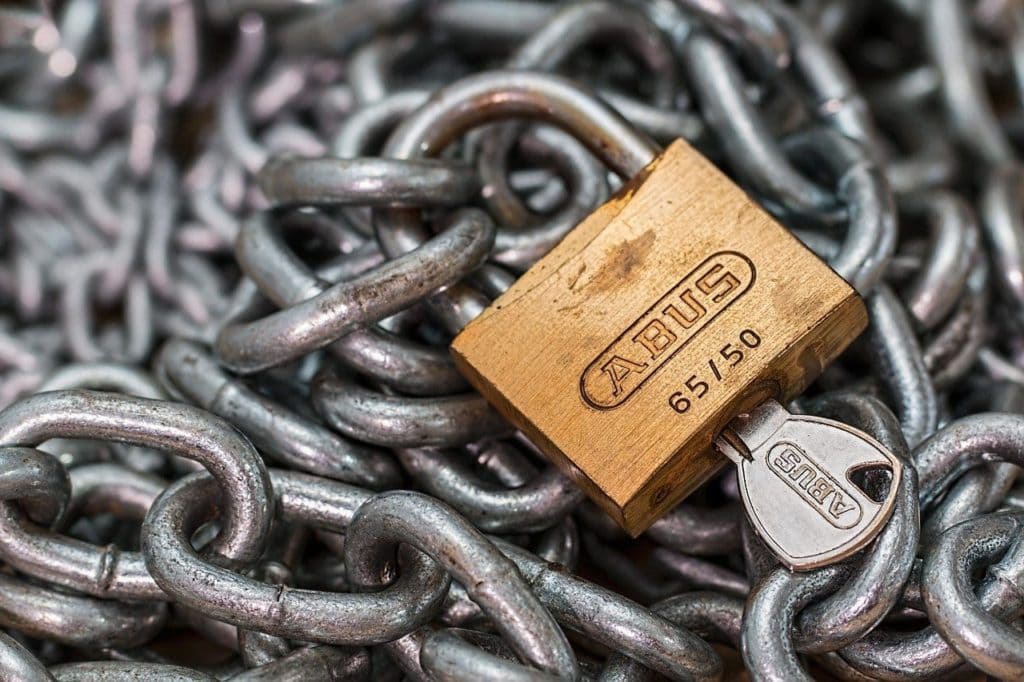What Should You Not Use WD-40 On? 11 Times It Shouldn’t Be Used
-

- Last updated:

WD-40 is found in many homes across the US. It’s cheap, effective, and widely available across the states. Another big pro is it has many different applications, which makes it a jack-of-all-trades type of product. However, you can’t use it on everything.
For example, if you put WD-40 on a door hinge, all the dust in the room will stick to it. The same is true for chains, locks, and anything made of rubber or plastic. The reason is that WD-40 is not just a lubricant but also a penetrant and moisture displacer. So, let’s take a quick look at the things that are NOT recommended to mix with WD-40!
 What Is WD-40? Breaking It Down
What Is WD-40? Breaking It Down
Invented in 1953, WD-40 (short for Water Displacement, 40th formula) hit the markets in 1961 and has been a go-to choice for American households for over four decades now. And the one thing that sets it apart from similar products is versatility. It can serve as a lubricant for squeaky doors, a degreaser for stubborn stains, and a rust remover against corrosion. More importantly, it’s easy to use and doesn’t cost a fortune.
All you have to do is squeeze the trigger on the spray bottle, and it will do the rest! People use it to treat dirty sinks, rusted blades, and stiff leather, to name a few. Produced by the WD-40 Company, this best-selling formula is a combination of various chemical compounds, including mineral oil, hydrocarbons, various alkanes, and carbon dioxide.

The 11 Times You NOT Should Use WD-40
1. Door Hinges and Latches
WD-40 is highly effective at eliminating squeaking doors, and you won’t have to remove the hinges or use half of the canister to get results. Just spray the hinges once or twice, and the annoying noise will disappear in the blink of an eye. However, while this product is, indeed, highly effective at lubrication, it’s also known to attract dust and dirt. This is a con that most penetrating oils share.
Over time, all that debris will accumulate on the hinges, worsening their performance. On top of that, you’ll end up turning the pins black, ruining the view. Instead, try using some graphite powder on the hinges and latches. While it can be a bit messy, graphite is an excellent lubricant that doesn’t leave marks or collect dirt.
2. Locking Systems

Keep this penetrating oil as far away from locks as possible. This is especially true for pin tumblers. If the spray gets deep into the locking system, it will make it wear out. And it doesn’t really matter whether you’ve got a padlock or a door lock—the negative effects will be the same. Just like with door hinges, graphite powder is a safe and efficient alternative.
Don’t have any lying around? That’s ok: go with silicone spray instead. As the name suggests, this solution is silicon-based, while WD-40 is formulated from petroleum. That means it won’t damage the internal mechanisms inside the lock. It can be used on door hinges, latches, garage doors, and other hardware to achieve better freedom of movement.
3. Motorcycle Chains
America’s favorite penetrating oil won’t do much good when used on bike chains, either. In fact, the side effect will be the same as with a hinge: accumulation of dirt and dust. It will only take a long ride around the block for the dirt from the ground to stick to the chain, rendering it useless. That’s because WD-40 offers immediate—but not long-lasting—lubrication. So, what’s the alternative here?
Opt for motorcycle-specific lubricants that are formulated with bikes in mind. For maximum efficiency, look for a product that’s rich in Teflon (PTFE). It will do an excellent job of lubricating the chains. This applies to all drive chains out there that are used for power transmission, including the ones you see in agricultural machinery, mills, coal cutters, and power tools.
4. Things Made of Rubber

Bushings and rubber gaskets made to create a tight seal between two metal parts have low tolerance against WD-40. The rust-dissolving compounds inside of this product will break down thin and soft rubber. WD-40 is bad news for many types of alloys as well, but mostly, it damages rubber and plastic (we’ll talk about that next). Now, spraying it once or twice won’t necessarily ruin your gaskets or seal rings. But, if you keep at it, the aggressive chemicals will, eventually, dissolve rubber.
5. Certain Types of Plastic
Plastic comes in all shapes and sizes, and in some ways, WD-40 is safe to use on it. However, this can’t be said about polystyrene and polycarbonate. Therefore, greenhouses, Styrofoam, baby bottles, gun handles, and DVD cases are off-limits. The petroleum distillates contained within the oil are capable of breaking down (disintegrating and discoloring) certain plastics.
To play it safe, only use mineral oil-based lubricants on plastic because you can never be 100% sure about its chemical composition. Again, silicon spray will be a great pick here: it’s cheap, harmless to plastic, and can handle even the most stubborn stains.
6. Firearms

One of the biggest pros of WD-40 oil is that it attracts and retains water (moisture molecules, to be exact). That’s bad news for firearms, though. While WD-40 will make cleaning the surface of a gun a walk in the park, if it gets into the firearm, that will make all the “insides” rust. Pistols, shotguns, automatic rifles—this rule applies to all types of guns.
7. Paintball Guns and Other Toys
These toys are usually crafted from aluminum. It’s a sturdy, rust-resistant, and lightweight material. The O-rings/seals, however, are mostly plastic or rubber. As we learned earlier, it doesn’t take WD-40 much effort to dissolve most types of plastic and rubber materials. So, cover the seals before you spray the gun. Don’t use any WD-40 on Rubik’s cubes, either.
Yes, we know these things tend to get a bit “rusty” after a couple of years, but WD-40 won’t fix that. Instead, it will ruin the insides of the cube: this penetrating oil is rich in paint thinners that make short work of Rubik’s famous invention. Just lube it using silicone spray or Vaseline (only add a couple of drops).
8. Electronic Devices

WD-40 and plastic are NOT a good match. So, if you have a dirty keyboard, a faulty Home button on an iPad, or a dusty old iPhone, using it will only make matters worse. Depending on how much of it you spray, the oil might “chew” through the plastic. And if some of it gets inside the device where the electronic components are, you’ll have an even bigger problem on your hands.
Apple recommends against using solvents or sprays to clean their devices. To avoid damaging your tablet or Smartphone, grab the softest cloth you can find, dip it into a bucket of lukewarm water, and be very gentle with the wiping. Also, make sure no moisture gets into any of the ports or openings. Musical instruments are very easy to ruin with WD-40 as well, by the way.
9. Engines and Fishing Gear
First, WD-40 isn’t a very strong lubricant. You’ll have to use tons of it to get gears back to life. Even then, the effects won’t last, making this a waste of money. More importantly, WD-40 shouldn’t be sprayed on any equipment, machine, or hardware that tends to get hot. A great example of that is a car engine. Obviously, you shouldn’t put it INSIDE of the engine, either, unless you want to damage it.
Now, speaking of fishing gear, we mostly mean the hooks and the fishing lines. Many folks around the country like to treat their fishing hooks with WD-40 because they believe it attracts fish. But that’s one big myth. Using penetrating oil will only pollute the water. It might even scare away the fish. As for the line, it will become weaker. So, just get a new set of hooks and fish lines. Fortunately, they’re not at all expensive.
10. Flames and Sparks

WD-40 is extremely flammable. Even if you spray it once or twice on fire or some sparks, you’ll run the risk of burning yourself. In many ways, this lubricant acts as a lighter fluid. Make a habit of never using it on any cables, wires, and other electrical contacts. If some of the insulation is worn out or torn, putting even the tiniest amount of WD-40 on those exposed cables can lead to a disaster!
11. Stiff Joints
Inflammation/swelling of joints can be very painful, and there’s a common misconception that the WD-40 lubricant is capable of relieving some of that pain. But it’s not backed by any medical research. WD-40 Company doesn’t recommend using its product to treat arthritis. There are dozens of effective (and relatively affordable) creams and oils available on the market—use them instead.
If you did rub WD-40 into your joints, be quick to wash it away using water and soap. It contains large amounts of petroleum distillates and might irritate your skin, depending on how sensitive it is. Furthermore, if it gets into your lungs (by breathing it), that can lead to the development of lipoid pneumonia.
 Cheap Alternatives to WD-40
Cheap Alternatives to WD-40
There are dozens of commercial oil and silicon-based products on the market that perform similarly to WD-40. You don’t have to buy any of those solutions, though. Instead, why not go with folk remedies that have proven their worth? For removing stains on floors, cabinets, sinks, and other surfaces, baking soda is a go-to solution. Use vinegar, dish soap, and hydrogen peroxide against stubborn stains and rust.
Or, you might want to opt for a little bit of lemon juice (mixed with vinegar) and salt. For lubrication, try applying some petroleum jelly. It’s mostly used to moisturize dry skin but can also fix squeaking doors, stuck metal joints, and more, just like olive oil and plumber’s grease. If you’re ready to pay for a lubricant, graphite powder and silicone spray are your best bets.

Best Uses for WD-40
Alright, now that we’ve covered what WD-40 should not be sprayed on, here’s a quick look at the top uses for this penetrating oil:
- Cleaning tile floors: If you’ve ever tried cleaning a tile floor, you know that getting rid of the dirt in between the grout lines can be a pain. Spraying a healthy amount of WD-40 will help with that. As a bonus, this oil will hide scuff marks, making the floor look brand-new. Don’t forget to rinse the floor after you’re done.
- Removing stains from sinks: Stainless steel is highly resistant to corrosion; however, it’s not that great against hard water stains that develop over time. Now, some baking soda and vinegar will be able to clean the stains, but with WD-40, you’ll get the job done faster. This is true for steel valves and faucets as well.
- Stretching leather: WD-40 is penetrating oil, and, just like most oils, it’s a perfect remedy against stiff leather. For example, if you have a leather tool belt, bag, or pair of shoes that need some stretching, this lubricant can soften them for you. This doesn’t apply to every type of leather, though. Make sure to check that before using it.
- Cleaning rust: WD-40 excels at getting rid of rust. Mostly, it’s used on rusted saw blades. Now, if they’re covered in gunk, that might be a bit harder to deal with, but WD-40 will still be useful in breaking at least some of it down. Take it slow—don’t spray half of the can onto the blades in one go.
- Getting rid of goo. Sticky substances take a lot of effort to remove. We’re talking about sticker residue, duct tape, and even gum stuck in someone’s hair. With WD-40, you’ll be able to remove all of that within seconds. Spray some of it on a paper towel and get to scrubbing.
 In Conclusion
In Conclusion
WD-40 is an incredibly popular brand in the United States and beyond. It’s affordable, easy to use, and comes in impact-resistant cans. It’s advertised as a universal penetrating oil that’s capable of removing rust, lubricating metallic parts, and keeping garden tools grease-free. However, while this is, indeed, an excellent product, sometimes, using it will cause more harm than good.
And, while ruining a rubber gasket or plastic handle won’t be that big of a deal, jamming up a gun, starting a fire, or hurting your joints can lead to unwanted consequences. Today, we talked about 11 situations when it would be better to keep that WD-40 bottle away. Use our list as your guide next time you decide to spray it, and stay safe!
- Sodium Bicarbonate (Baking Soda)
- The Nitty Gritty of Stains
- How to Remove Rust from Tools
- Facts You Never Learned in School
- Graphite Powder
- Amsoil.com – What is Silicone Spray?
- WD-40 acts as a joint lubricant and pain reliever
- Reader’s Digest – 5 Times You Should Never Use WD-40
- How to clean your Apple products
- Bike Chain Cleaning and Maintenance
- Paint Gun Industry O-Rings
- Can WD-40 Help Arthritis?
- Safety Data Sheet
- Is Teflon Coating Safe?
- What’s Inside WD-40?
Featured Image Credit: Benedek Alpar, Shutterstock
Contents
 What Is WD-40? Breaking It Down
What Is WD-40? Breaking It Down Cheap Alternatives to WD-40
Cheap Alternatives to WD-40